Perch have seen a recent boom in weights over the last 10 years and if ever there was a time to catch a monster stripey then now is as good as ever. Big perch seem to be coming from all water types and most anglers should have access to venues containing big perch within a reasonable distance of their home.
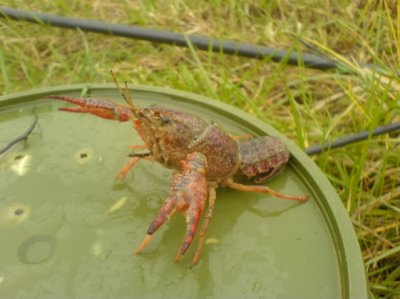 So what makes for a good perch water? In my opinion the most important factor is an abundance of prey.
So what makes for a good perch water? In my opinion the most important factor is an abundance of prey.
From an early age perch develop a voracious appetite and anything that can fit into its cavernous mouth is fair game, be it fish, invertebrates or crustaceans. In recent years the spread of American signal crayfish has been a contributing factor to the massive growth rates of perch seen in this country today; certainly any water that sustains a population of this clawed critter invariably holds big perch.
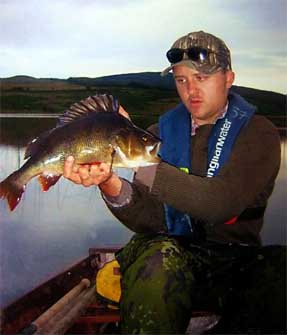 |
| A Dream Perch of 4Ib 8oz |
An often used quote in angling is that “Pike thrive on neglect”. The same can be said for perch, especially big ones. Look for waters off the beaten track which are receiving limited amounts of angling pressure. Waters that have a history of producing big perch are always worth considering, and above all else, keep your ear to the ground – you never know where big stripeys will turn up next. From canals to rivers, streams to ponds, drains to vast Scottish lochs – all have the potential to produce the Perch of your dreams
Seasonal Changes
Perch as a species have often been associated with autumn and winter fishing. They can be caught at all times of the year. It has to be said that angling for perch on rivers in the winter or by small pools and lakes in the autumn is very traditional, however on some of the larger natural lakes and Scottish lochs fishing at these times of the year can be uncomfortable and downright dangerous, especially if you are going afloat for these predators.
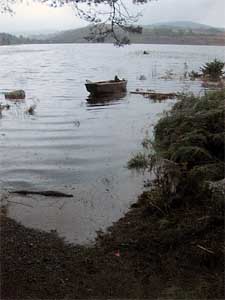 |
| Flooded out on a Scottish Loch |
In recent years, more and more of my fishing for perch has taken place on large glacial lakes and Scottish lochs. With this in mind I like to pursue perch after spawning has taken place in April. Good fishing can be found through the remainder of the spring and on into the summer and autumn. For some reason May and September seem to be very productive months on these larger waters.
Once winter kicks in I find that conditions can become hazardous and location of the fish becomes harder. Also given the extreme winters we seem to now be experiencing, even getting to these wild waters, let alone fishing them, is a challenge in itself and no fish is worth putting yourself or others in danger for.
Tactics.
As I have already mentioned, most of my fishing for perch now takes place afloat on large natural lakes. One method that I have had real success with has been with trolled lures. For the remainder of this piece I want to give you an overview of the tackle, lures and techniques that I use on these waters as I feel that it is a method that is largely ignored. It seems that a lot of these waters are targeted by pike anglers who are using big baits and lures and as a result the perch are largely avoided.
I too was one of these anglers and it took a freak capture of a big perch on a jerkbait for me to re-assess my approach. On my next trip I brought along a light lure outfit and managed to catch a brace of 2lbers and a cracker of just over 3lb. There seemed to be something in this method when used on these venues and it was a technique that I began to explore more and more.
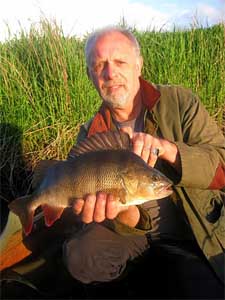 |
| A superbly conditioned Perch taken on the troll by my father, Stewart Taylor. |
We all know the effectiveness of baits such as lobworms and livebaits when it comes to targeting Perch, so why use lures?
Well for a variety of reasons. Firstly by trolling lures from a boat you can cover large areas of water over the course of the day thus presenting your bait to far more fish than that of an angler who is fishing static. But for me the most important factor is that lures of the right size are selective. By using lures in the 2-5in category you will be offering a bait that is more likely to be taken by a large perch. It’s true small perch will take these, but more often than not by using baits of this size you will be appealing to the predatory instincts of bigger perch. As with small perch, pike will also take these offerings but again they are more likely to show a preference for bigger baits.
Pike captures are inevitable and for that reason a wire trace is always essential. Forget all this rubbish about wire putting off perch and DO NOT be tempted to use light fluorocarbon leaders as they are a death sentence for pike! Look for a supple low diameter wire, there are various brands available on the market. Personally I like to use “Drennan Green Pike Wire” in 15lb breaking strain. Do beware though as this wire can start to kink after a few rogue pike captures. At the first signs of wear change the trace immediately. Another brand worth looking at is “Wonder Wire” which is highly recommended on internet lure fishing forums although as yet I haven’t used this wire.
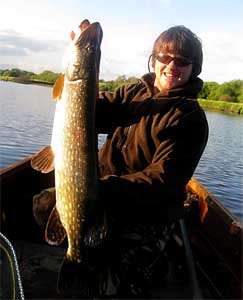 |
| A nice Pike taken on a small crankbait intended for Perch |
Choosing lures
We have established a good size range of lure for perch but what types should we be looking to use? There are literally thousands of lures on the market and it can seem overwhelming to a newcomer to choose a suitable bait. As this piece mainly concerns trolling for perch our first choice lure to look at would be the crankbait. Again there are many crankbaits so it is important to select the right one.
An important aspect with lure choice is to consider the “running depth” of a given lure. “Running depth” is a phrase used to describe the depth at which a lure will dive to when retrieved. Crankbaits have a plastic vane fitted at the front end of the lure and a simple rule to follow is if the vane of the lure is large then the bait will be a deep diver. Obviously lures with small stubby vanes are shallow runners.
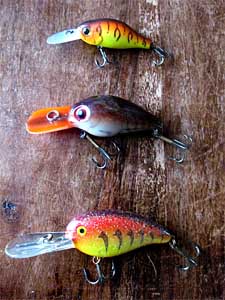 |
| Deep diving crankbaits |
Look out for models such as Big S, Bagley Killer B, Fox Fat Willy, Manns Minus , Speedkid 56, Wiggleworts etc.
I like to use deep diving lures when exploring underwater features such as drop-offs, plateaus and reefs.
Shallow diving lures have been a good choice to use when trolling over submerged weedbeds in shallow water or when run alongside reed lines.
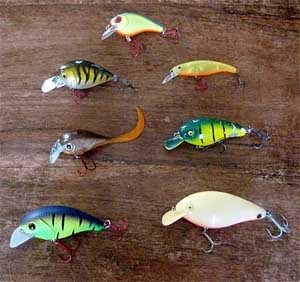 |
| Shallow diving crankbaits |
The next thing to consider is the lures action. Look for lures that have a good wide wobble and produce plenty of “throb”, these seem to really attract perch. It is also worth considering sound. Lures containing rattles have been productive, although I have come to no fixed conclusions over which is more important, vibration or sound, they seem to be equally as important and a lure that possesses both of these attributes will often be the days’ most productive bait.
Going Bananas!
One type of lure that I have had great results using is the banana-shaped trolling lure. These have a very fast and wide wobble.
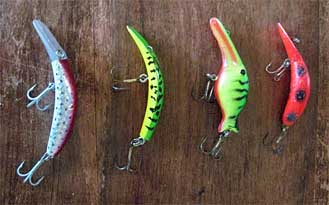 |
| Banana Shaped Trolling Lures |
This type of lure is deadly for big perch. If there is one lure that is a must to have in your collection then this style is it; look out for the following makes – Heddon Clatter Tadpoll, The Hotshotter lure, Llur Jenson, Kwick Fish and Elmo’s Zip Fish.
I don’t know what it is about this type of bait, but it produces the goods time and time again both for me and my angling companions. At the time of writing this style of lure has accounted for numerous 3lb+ perch and four over the magic 4lb mark.
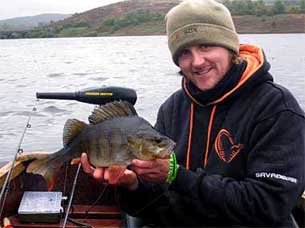
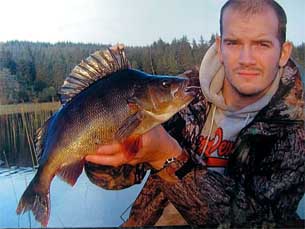
A couple of large Perch taken on “banana lures” for myself and angling companion Nick Hulmes.
One more type of lure to consider is the humble spinner. Although not a crankbait this lure can still be trolled. I have to admit that it was a lure that I had neglected in favour of more modern crankbaits, however I found out to my cost how deadly these lures could be when last summer my Dad landed an absolute brute of a perch weighing in at 4lb 2oz on a simple Mepps spinner. I think that most anglers will have a few spinners in their collections and now I wouldn’t be so quick to scorn them as a “has been lure”
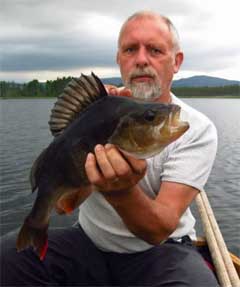 |
| A brute of a perch |
One final thought to consider when choosing lures for perch is colour. If ever there was a subject that can divide lure anglers then this is it.
When fishing for pike I don’t think that lure colour is of any real significance. Lure size, action and running depth are far more important aspects to consider. However over the last few years I have come to the conclusion that lure colour is very important when it comes to targeting perch.
Perch are predominantly sight feeders and I would hazard a guess that this sense is their primary hunting tool. A lot of the Scottish Lochs that I target have peat stained water. For some reason “hot” coloured lures far outfish subdued or “natural” lure patterns. Firetiger, chartreuse, reds etc seem to “glow” in the stained water and show up much better than, say a silver Roach coloured lure.
I ran a little experiment on one session. This involved trolling two “Heddon tadpole” lures, one silver and one “hot orange”. The orange lure out-fished the silver one 10 to 1. I suppose many lure anglers will remain sceptical, but judging by my own experiences and results on these waters a brightly coloured lure will always be my first choice.
Tackle.
Obviously to troll lures you are going to need a boat, some sort of engine and possibly an echo sounder. I use a small 12ft wooden rowing boat coupled with a Minn Kota “classic” 28lb thrust electric engine. I find this sufficient to propel my small boat; you may need an electric engine with more power if your boat is bigger.
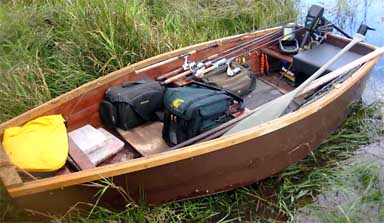 |
| All loaded and ready to go |
I find an echo sounder invaluable. I use a “Hummingbird” some anglers frown on their use but I would be lost without one as it allows me to assess the correct depths in which I am fishing. Having knowledge of the depths you are fishing is important as it helps with choosing the correct type of lure, be it shallow or deep running.
The sounder also helps interpret underwater “structure” such as sunken weedbeds, plateaus, reefs or shoals of baitfish, all of which are a big draw to predators. To cover the ins and outs of boats and echo sounders is an article in itself and I don’t have the space to go into too much detail here.
I find rods of 7ft a good length to use, especially when trolling from a boat. Avoid rods that are too stiff as you want to enjoy the scrap from even a modest sized perch, also if the rod is too powerful there can be a risk of tearing the lure from the perch’s mouth. You however want to compromise as pike can be encountered and trolling with deep diving plugs can put extra pressure on rods, so you do need a little backbone in the rod.
Some of the modern jig rods on the market have very sensitive tips which are not suitable for trolling so avoid these. The rod that I am currently using is the Drennan, Esox, Spinflex. This is 7ft in length with 1.5lb TC. It is a good compromise rod as it has the backbone to troll deep diving plugs and set hooks into the perch’s bony mouth, yet the fish can still give a good sporting account of itself. Another plus point is the price, as it retails around the £40 mark. A good guide is to look for rods of 15-30 grms with a length of between 7 and 9 foot.
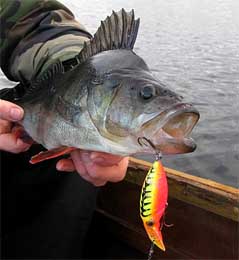 |
| Caught on a deep diver |
Look for small reels in the 2000 class and load them with either 15lb or 20lb braid.
I hope this article has given you a brief overview of the tackle and tactics that I use to target big perch. With a bit of luck this may inspire you to give lures a go. Trolling lures for perch is becoming a big passion of mine and it seems that it is a method that is not largely practiced. There is something addictive about catching big stripeys on lures as it is a very active and stimulating method.
Nothing beats watching a rod rhythmically pulse in time with your lure as you troll along a reedline. Expectancy is high, but time trickles by… Without warning the tip savagely pulls round and you feel the headshaking thump of an angry perch …………………………… pure bliss!
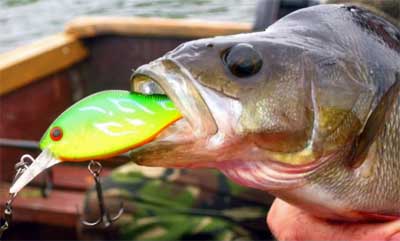
Danny Taylor.











